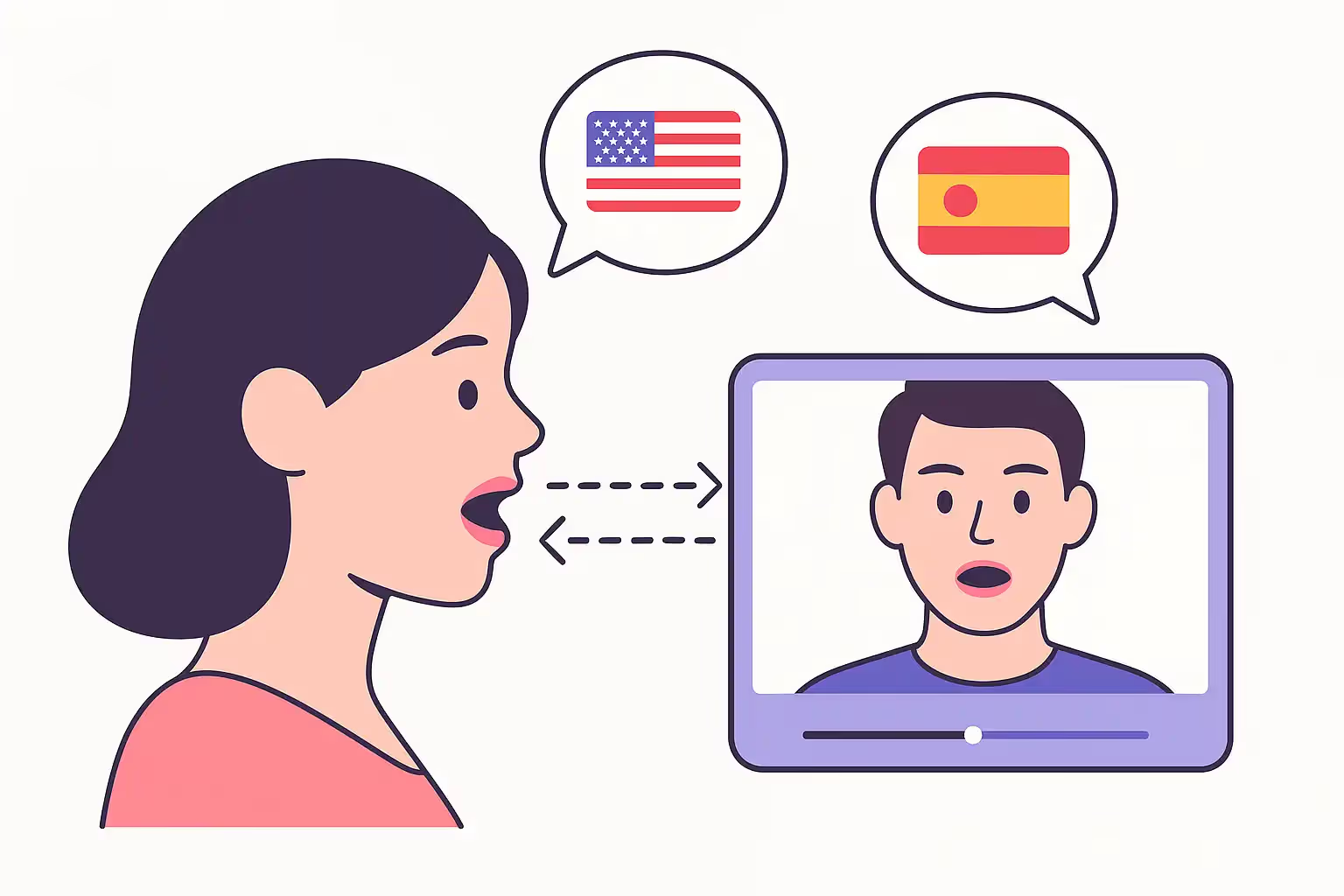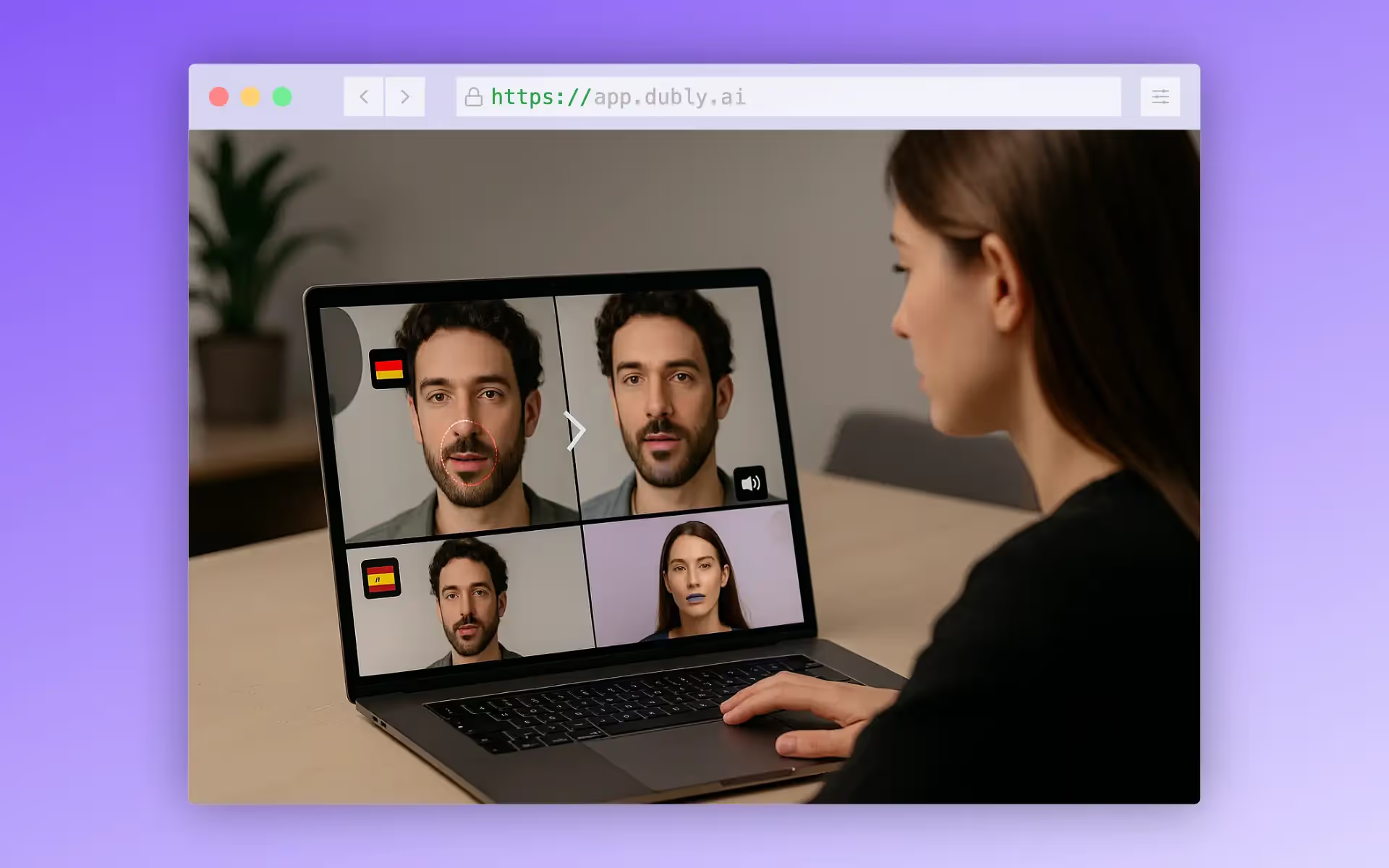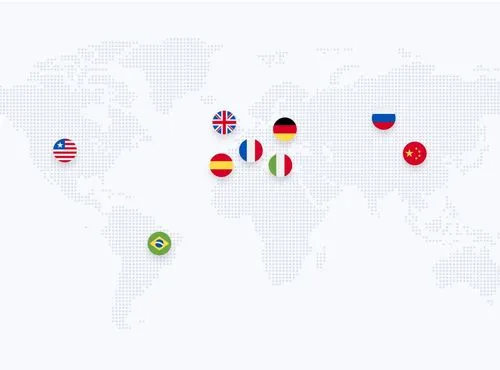Tech
September 12, 2025
Perfect Lip Sync: Why It Matters – and Why Most Tools Fail

From "good enough" to truly synchronized
In the past, Lip Sync meant trying to cut and time a translated audio track to roughly match the speaker’s mouth movements.
It was always a workaround – and rarely convincing.
Today, things have changed.
Thanks to AI, we can now actively adjust the lip movements in the original video to match the translated audio – precisely, naturally, and without visual glitches.
Instead of post-production tricks, we now get results that look and feel like the video was recorded in the new language. But only if it’s done properly.
What is Lip Sync, really?
Lip Sync (short for “lip synchronization”) is the alignment between the spoken audio and the visible mouth movement in a video.
The goal: Viewers should feel like the person on screen is genuinely saying what they’re hearing – regardless of the language.
Achieving that requires more than just timing. It involves:
- Correct articulation (which visible sounds are being formed)
- Sentence rhythm, tone, and pauses
- Facial expressions and movement dynamics
Only when all of this aligns does the result feel real.
Why Lip Sync is so important
Lip Sync is not a nice-to-have – it’s mission-critical for:
- Credibility: Even small mismatches between voice and lips look fake.
- Trust: Especially in leadership videos, learning content, or testimonials.
- Professionalism: Visual dissonance can cheapen even the best message.
- Emotional resonance: Humans instinctively read faces – and if the movement doesn’t match the sound, we disconnect.
If your video shows people talking directly to the camera, strong Lip Sync isn’t optional – it’s essential.

Why 80% Lip Sync isn’t enough
Many tools claim to offer automatic Lip Sync.
But they mostly hit the general rhythm – not the real detail.
- One wrongly timed phoneme? It shows.
- Even a slight lag? Feels robotic.
- Incomplete sentence movement? Looks wrong.
Lip Sync is binary: It’s either perfect, or it doesn’t work.
There’s no room for "close enough" when it comes to faces – we notice every tiny inconsistency.
{{cta}}
How Dubly.AI delivers real Lip Sync
At Dubly, Lip Sync is applied only at the very end of the translation process – after:
- the video has been translated,
- the voice track optimized,
- and (optionally) Voice Cloning applied.
Then, our system analyzes:
- The original lip movements
- The translated speech (timing, intonation, phonetics)
- Context such as sentence structure and camera angle
Based on this, the lip movements in the video are dynamically adjusted – frame by frame, voice by voice – without altering the rest of the face or visuals.
The result: A natural, visually convincing translation that feels like it was shot in the target language.
Why most tools fail at Lip Sync
A lot of platforms advertise Lip Sync – but:
- Some use avatar overlays or generic animations
- Others rely on fixed rules like "one sound = one mouth shape"
- Many just stretch the audio without touching the visuals
This often leads to an uncanny valley effect. At best, it’s distracting. At worst, it ruins the message.
Dubly does it differently.
We use visual AI built for real human faces – no masks, no avatars, no gimmicks. Just precise, high-quality Lip Sync tailored to your actual footage.
FAQ: Why Perfect Lip Sync Matters and Where Others Often Fail
What is lip sync really?
Lip sync is the precise alignment between spoken audio and mouth movements in video. It means matching not just timing but phonetics, expression, tone, pauses—so that it looks like the person is truly speaking the translated audio.
Why does perfect lip sync matter?
Because even a slight mismatch undermines credibility. In videos where the speaker looks at the camera, or in messages with emotional or trust content, imperfect lip sync causes visual dissonance, reducing engagement, trust, and perceived professionalism.
What do most tools do wrong with lip sync?
Many only approximate timing, stretch audio, or use generic rules like fixed mouth-shapes. Others skip adjusting visual mouth movement entirely. The result is robotic, detached, or “off” feeling lip synchronization.
How does Dubly.AI achieve real lip sync?
Dubly runs lip sync as the final step after translation, voice-track optimization (and optionally voice cloning). The system analyzes original lip movements, translated audio (pronunciation, rhythm, phonetics), and context (sentence structure, camera angle), then dynamically adjusts lips frame by frame without altering other facial features.
In what situations is lip sync especially critical?
When people speak directly to camera, in leadership messages, emotional storytelling, testimonials, ads, international content for platforms like YouTube or social media, or any case where visual authenticity contributes to brand trust.
{{callout}}
Conclusion: Lip Sync is not a feature – it’s the foundation
You can get the translation right. You can have a great voiceover. But if the lips don’t match the message, the illusion breaks.
Dubly.AI delivers true Lip Sync – as the final polish that elevates your translated video to broadcast-ready quality.
It’s the difference between understood and believed.
Does the Dubly.AI free trial include the Lipsync feature?
Yes. We believe you need to experience the full technology to understand its value. The free trial includes Generative Lipsync and Voice Cloning, not just simple audio translation.
Is there a difference between a standard "Video translater" and Dubly.AI?
Yes. A standard "Video translater" often only translates text or audio. Dubly.AI is a comprehensive AI solution that adapts the visuals (mouth movements) to the audio, creating a seamless experience.
Can I use Dubly.AI for long-form content?
Yes. While many free tools limit you to 60 seconds, Dubly’s engine is built for scale – from TikTok Shorts to hour-long corporate training modules.
Can I use translate video free tools to internationalize my content?
Yes, absolutely. Using free tools is a great starting point to test new markets without a budget. However, keep in mind that methods like subtitles or basic video translator apps usually only transfer information, not emotion. To truly internationalize your brand's personality and retain viewers, you will eventually need lipsync technology to ensure the audience feels connected to you, not just the text.
Does a free ai video translator work for all types of videos?
It works well for content where the speaker is not visible, such as screen recordings or faceless tutorials. However, for any video featuring a person speaking on camera, a standard tool often falls short. Because it lacks lipsync, the visual mismatch distracts the viewer. For content meant to build trust or emotion, you need a solution that adapts both the voice and the visuals.
Is there a free version of Dubly.AI?
You can translate your first video for free so you can validate the quality with your own files. We believe in letting you prove the value first.
Does this work for any language?
Our AI supports over 30 languages, covering the majority of global markets (English, Spanish, German, French, Japanese, Mandarin, etc.). The Lip Sync works universally across these languages.
How accurate is the translation?
AI translation is very good (95%+), but for critical content, context matters. That is why we offer Native Speaker Control (NSC) as an add-on, where humans review the AI's work. This combines the speed of software with the precision of a native speaker.
Can I automate this process?
Yes. For agencies, media houses, or companies with high volume, we offer an API. This allows you to integrate video translation directly into your content management workflow, removing manual upload steps entirely.
Über den Autor

Newest articles

Use Cases
How to Translate Video Free: 3 Ways to multiply your reach
Looking for an AI video translator? We answer how to translate video free using 3 methods: Subtitles, Basic TTS, and Professional Lipsync.

Simon Pieren
December 8, 2025

Use Cases
Translate Video Free: A Guide to AI Translation, Lip Sync & Voice Cloning
Looking to "translate video free"? Learn the technical differences between standard dubbing and generative AI Lip Sync, and how to test professional quality risk-free.

Simon Pieren
November 28, 2025

Use Cases
How AI Video Translation Connects Global Teams
How AI video translation breaks down language barriers in enterprises - secure, empathetic, and scalable.

Simon Pieren
November 24, 2025
